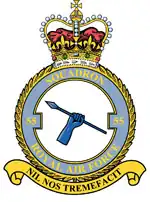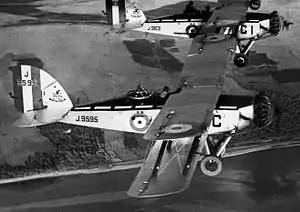No. 55 Squadron RAF
Number 55 Squadron was a flying squadron of the Royal Air Force (RAF). First formed in April 1917, the squadron saw action on the Western Front during the First World War. Based in the Middle East during the interwar period and the Second World War, No. 55 Squadron saw action over Iraq, Egypt, Libya and Italy. Between 1960 and 1993, the unit flew the Handley Page Victor. Initially on the Victor B.1A before becoming a tanker squadron in 1965 with the Victor B(K).1A/K.1/K.1A before converting to the Victor K.2 in 1975. Disbanding in October 1993, No. 55 Squadron were the last RAF unit to operate the Victor. Between 1996 and 2011, No. 55(Reserve) Squadron operated the Hawker Siddeley Dominie T.1 from RAF Cranwell, Lincolnshire, helping to train navigators for the RAF.[3]
| No. 55 Squadron RAF | |
|---|---|
 | |
| Active | 27 April 1917 – 1 April 1918 (RFC) 1 April 1918 – 22 January 1920 (RAF) 1 February 1920 – 1 November 1946 1 September 1960 – 15 October 1993 15 October 1993 – 31 March 1996 1 November 1996 – 20 January 2011 |
| Country | |
| Branch | |
| Type | Flying squadron |
| Motto(s) | Latin: Nil nos tremefacit (Nothing shakes us)[1][2] |
| Battle honours |
|
| Insignia | |
| Squadron badge heraldry | A cubit arm, the arm grasping a spear |
History
First World War
No. 55 Squadron was formed during the First World War at Castle Bromwich, West Midlands, on 27 April 1916.[4] It initially operated as a training unit, flying a mixture of aircraft types, including the Avro 504, Royal Aircraft Factory B.E.2, and the Armstrong Whitworth F.K.8, but in January 1917 it changed its role to a day-bomber squadron, and re-equipped with the Airco DH.4, being the first squadron to receive the new light bomber.[1][5][6][7]
It took these to the Western Front in France on 6 March that year as part of 9th Wing, flying its first bombing mission against Valenciennes railway station on 23 April 1917 in support of the Battle of Arras.[8] Having been based at Tantonville where muddy conditions hampered operations, it moved at the beginning of June 1918 to Azelot.[9] It became part of the Independent Air Force as part of No 41 Wing,[10] carrying out daylight strategic bombing missions against targets in Germany, along with reconnaissance duties.[1][6] 55 Squadron developed tactics of flying in wedge formations, bombing on the leader's command and with the massed defensive fire of the formation deterring attacks by enemy fighters.[11] Despite heavy losses, 55 Squadron continued in operation, the only one of the day bombing squadrons in the Independent Force which did not have to temporarily stand down owing to aircrew losses.[12] The squadron flew 221 bombing missions during the war, dropping approximately 141 long tons (143,000 kilograms) of bombs during the war.[13]
Following the Armistice on 11 November 1918, 55 Squadron was briefly used to run airmail services to British forces, before returning to the United Kingdom and relinquishing its aircraft in January 1919,[1] formally disbanding on 22 January 1920.[5]
Between the Wars

The squadron reformed on 1 February 1920, when No. 142 Squadron, based at Suez and equipped with Airco DH.9s was renumbered.[1] It started to receive more capable Airco DH.9As in June 1920, and was equipped with a mixture of DH.9s and DH.9As when it transferred to Turkey onboard HMS Ark Royal in July to support the 'Q Force' of the British Army who were defending Constantinople and the Dardanelles.[1][14][15]
55 Squadron moved to Iraq in August 1920 to take up 'air policing' duties.[1] It arrived in Baghdad in September 1920, discarding its remaining DH.9s to standardise on the DH.9A.[16] The squadron moved to Mosul in March 1921, and to RAF Hinaidi in May 1924.[16] It remained in Iraq for 19 years, on occasion flying air policing operations against rebelling tribesmen. The ageing DH.9As were replaced by Westland Wapitis in February 1930, which in turn were replaced by Vickers Vincents in 1937,[1][17] taking these to RAF Habbaniya in September that year.[16]
It finally received modern monoplanes in March 1939, when it received twin-engined Bristol Blenheim bombers, transferring to Egypt just before the outbreak of the Second World War.[1][17]
Second World War
No. 55 Squadron flew its Bristol Blenheims on shipping patrols over the Gulf of Suez, until Italy declared war in June 1940, when 55 Squadron changed to operations against bombing targets in Libya.[1] On 11 June 1940, the unit participated in the first attack by the Royal Air Force on the Italian air force base at El Adem, where 18 aircraft were destroyed or damaged on the ground, against the loss of three British aircraft from three squadrons.[18] It changed to anti-shipping operations in September 1941, continuing these operations until it was withdrawn from operations in March 1942 for conversion to Martin Baltimores,[1] after which it returned to the bombing role.[17] The squadron continued in support of the Eighth Army for the remainder of the North African campaign.[1]
It flew its Baltimores on bombing raids in support of the Allied invasion of Sicily, and the subsequent invasion of Italy. It re-equipped with Boston light bombers in October 1944.[1][17] The squadron moved to Hassani in Greece in September 1945,[1] replacing its Bostons with de Havilland Mosquitos in June 1946. 55 Squadron disbanded in December 1946, and was removed from the RAF's Order of Battle.[1][5]
Handley Page Victor


Following a hiatus of nearly fourteen years, No. 55 Squadron reformed at RAF Honington in Suffolk on 1 September 1960 equipped with the Handley Page Victor,[5] when it became part of the V bomber force of RAF Bomber Command.[1] 55 Squadron became the fifth Victor squadron when it received Victor B.1A variant.[19] When the Vickers Valiant (a V force stable-mate) was grounded in December 1964 owing to metal fatigue, the Royal Air Force lost its aerial refuelling tanker force, and a rush programme was launched to convert Victor B.1s to fill the tanker gap. From May 1965, when 55 Squadron moved to RAF Marham in Norfolk,[16] it received six interim two-point Victor BK.1A tanker conversions,[1] allowing it to become operational in the air-to-air refuelling tanker role in August 1965.[20] It had replaced the interim BK.1As with the definitive three-point tankers (Victor K.1 and K.1A) by December 1966, retaining them until 1975, when they were replaced by the more powerful Victor K.2.[17]
55 Squadron provided aerial tanker support during Operation Corporate, the Falklands War in 1982.[1] This notably included the Operation Black Buck raids on Stanley Airfield, where alongside 57 Squadron, its fellow Victor squadron, they refuelled Avro Vulcan bombers multiple times to allow them to reach the Falkland Islands from Ascension Island,[1] at that time the longest bombing raid in history. 55 Squadron's Victors went to war again in 1991, when it was deployed to the Persian Gulf as part of Operation Granby,[1] the United Kingdom's response to the Iraqi invasion of Kuwait, refuelling British and coalition aircraft during Operation Desert Storm.[21][22] 55 Squadron disbanded on 15 October 1993, the last squadron to operate the Victor.[23][24]
Training roles
On the same day as No. 55 Squadron disbanded as a Victor squadron, 241 Operational Conversion Unit at RAF Brize Norton was renumbered No. 55 (Reserve) Squadron.[24] This OCU was responsible for training Vickers VC10[1] and Lockheed TriStar crews, although it had no aircraft of its own.[25] Disbanding again on 31 March 1996, it reformed at RAF Cranwell on 1 November 1996 when the navigation squadron of No. 3 Flying Training School, flying Hawker Siddeley Dominie T.1, weapon systems officer (WSO) and weapon systems operators (WSOp) trainers, adopted its identity.[1][25]
The Dominie T.1 was withdrawn from service, and the squadron disbanded, when WSO and WSOp training ended on 20 January 2011.[3]
References
Citations
- "55 Squadron". Royal Air Force. Ministry of Defence. Archived from the original on 11 October 2011. Retrieved 6 September 2010.
- Pine, L.G. (1983). A dictionary of mottoes (1 ed.). London, England: Routledge & Kegan Paul. p. 151. ISBN 0-7100-9339-X.
- "Farewell flypast for RAF's Hawker Siddeley". BBC News. British Broadcasting Corporation. 20 January 2011. Retrieved 25 January 2011.
- Halley 1988, p. 117.
- Halley 1980, p. 91.
- Ashworth 1989, p. 130.
- Bruce Flight 17 October 1952, p. 506.
- Bruce Flight 17 October 1952, p. 507.
- Williams, Frederick (2019). Coyle, James (ed.). Don't Let Them Bag The Nines. Cheltenham, Gloucestershire: The History Press. ISBN 9780750992923.
- Rennles 2002, pp. 5–6.
- Williams 1999, p. 84.
- Williams 1999, p. 195.
- Moyes 1964, p. 82.
- Ashworth 1989, pp. 130–131.
- Halley 1980, pp. 91–92.
- Halley 1980, p. 92.
- Ashworth 1989, p. 131.
- Playfair, vol. I, page 112.
- Mason 1994, p. 389.
- Gunston Aeroplane Monthly February 1981, p. 65.
- "Third Tornado squadron goes to Saudi Arabia". Flight International. 9–15 January 1991.
- World Air Power Journal Volume 5 Spring 1991, p. 35.
- Mason 1994, p. 390.
- March, Peter R. (1998). Brace by Wire to Fly-By-Wire – 80 Years of the Royal Air Force 1918–1998. RAF Fairford: Royal Air Force Benevolent Fund Enterprises. p. 160. ISBN 1-899808-06-X.
- "No 51 - 55 Squadron Histories". Air of Authority. Archived from the original on 23 January 2015. Retrieved 13 February 2011.
Bibliography
- Ashworth, Chris (1989). Encyclopaedia of Modern Royal Air Force Squadrons. Wellingborough, UK: Patrick Stephens Limited. ISBN 1-85260-013-6.
- Bruce, J.M. (17 October 1952). "The De Havilland D.H.4". Flight. pp. 506-510. Archived from the original on 20 May 2011.
- "Desert Storm: The First Phase". World Air Power Journal, Volume 5, Spring 1991. pp. 24–35.
- Gunston, Bill. "The V-Bombers: Handley Page Victor, Part 2". Aeroplane Monthly, Vol. 9, No 2, February 1981, pp. 60–65. ISSN 0143-7240.
- Halley, James J. (1980). The Squadrons of the Royal Air Force. Tonbridge, Kent, UK: Air-Britain (Historians). ISBN 0-85130-083-9.
- Halley, James J. (1988). The Squadrons of the Royal Air Force & Commonwealth, 1981-1988. Tonbridge, Kent, UK: Air-Britain (Historians) Ltd. ISBN 0-85130-164-9.
- Mason, Francis K. (1994). The British Bomber since 1914. London, England: Putnam. ISBN 0-85177-861-5.
- Miller, Leonard (1919). The Chronicles of 55 Squadron RFC and RAF. London, England: Unwin Brothers Ltd.
- Moyes, Philip (1964). Bomber Squadrons of the R.A.F. and their Aircraft. London, England: Macdonald & Co.
- Playfair, Major-General I.S.O.; Molony, Brigadier C.J.C.; with Flynn, Captain F.C. (R.N.) & Gleave, Group Captain T.P. (2009) [1st. pub. HMSO:1954]. Butler, Sir James (ed.). The Mediterranean and Middle East, Volume I: The Early Successes Against Italy, to May 1941. History of the Second World War, United Kingdom Military Series. Uckfield, UK: Naval & Military Press. ISBN 978-1-84574-065-8.
- Rennles, Keith (2002). Independent Force:The War Diary of the Daylight Bomber Squadrons of the Independent Air Force 6th June–11th November 1918. London, England: Grub Street. ISBN 1-902304-90-X.
- Williams, Frederick (2019). Coyle, James (ed.). Don't Let Them Bag The Nines. Cheltenham, Gloucestershire: The History Press. ISBN 9780750992923.
- Williams, George K. (1999). Biplanes and Bombsights: British Bombing in World War I. Maxwell Air Force Base, Alabama: Air University Press. ISBN 1-4102-0012-4.
Further reading
- Jefford, C.G. (1988). RAF Squadrons, a comprehensive record of the movement and equipment of all RAF Squadrons and their antecedents since 1912. Shrewsbury, Shropshire, UK: Airlife Publishing. ISBN 1-84037-141-2.
External links
![]() Media related to No. 55 Squadron RAF at Wikimedia Commons
Media related to No. 55 Squadron RAF at Wikimedia Commons